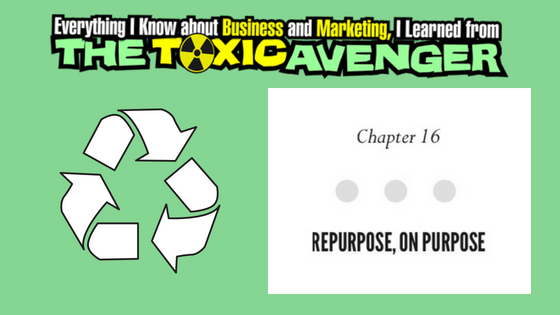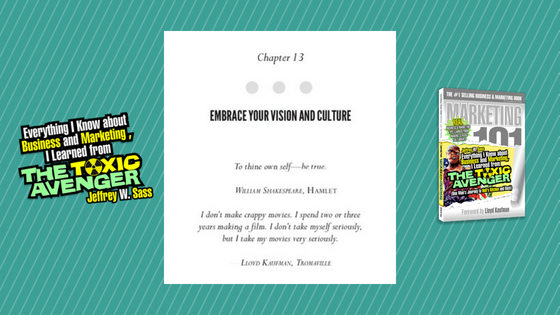Chapter 17: Always Salute the Schwag!
Greetings from Tromaville! Here is Chapter 17 from my book, Everything I Know about Business and Marketing, I Learned from THE TOXIC AVENGER. In this chapter, we take a look at the importance of always carrying… not weapon, but rather, marketing materials – SCHWAG! What do you think?
If you haven’t done so already, you can read the Foreword by Troma co-founder, Lloyd Kaufman, and the Introduction to the book as well as Chapter 1, 2, 3, 4, 5 and 6, 7 ,8, 9, 10, 11, 12, 13, 14, 15 and 16. You can also see me read a few chapters live, along with Lloyd and Toxie, at Florida Supercon as well as a few chapters I read on Facebook Live. Stay tuned for additional chapters to be published here. If you like what you read and can’t wait for more, please don’t be shy. You can buy the book now on Amazon (and also please don’t be shy about sharing, and reviewing the book when you do read it.) Both Toxie and I greatly appreciate your support! – Jeff Sass
Chapter 17: Always Salute the Schwag!
“I pledge allegiance to the schwag…of the United States of Tromaville.” As part of the Troma Team, I quickly learned the power of “schwag” and the importance of always “carrying.” In this instance carrying did not mean a concealed weapon, although one could argue that good schwag is an excellent sales and marketing weapon. In Tromaville carrying meant you were always equipped with a supply of stuff—stickers, flyers, T-shirts—schwag. Your briefcase was full of the stuff. If you owned a car, your trunk was full of the stuff. If you carried a purse or murse*, your purse or murse was full of the stuff. While representing the Troma Team, you never walked into a meeting empty-handed. You always had your schwag at the ready. Schwag sells.
There’s a reason printed paper flyers were called “sell sheets” in the movie business. They were also called “slicks,” perhaps because the slicker they were, the better they sold. For every movie in the Troma library, having a great key art image that became the basis of the poster, and then the smaller sell sheets was essential. As essential as having a good trailer. Arguably far more essential than having a good movie. Back in the day, especially in the realm of international film distribution, the sale (technically, the licensing) of a film for distribution to a small foreign market was often concluded based on the sell sheet and trailer alone, many times long before the film in question had actually been completed (or in some cases, even started). We were selling the dream. Selling the outcome. And schwag helped.
Like trusty Boy and Girl Scouts, always carrying schwag meant you were always prepared. You never knew when you’d have the opportunity to leave behind that flyer for Curse of the Cannibal Confederates or that gorgeous green “I love Toxie” sticker. And then there were the T-shirts. Especially the T-shirts. We would print bright-red (and sometimes yellow) “I made the Troma Team” T-shirts by the hundreds. They were inexpensive thin cotton tees with a big Troma logo on them, and people loved them. When it came to production time, our “I-Made-the-Troma-Team” tees were like a liquid currency. They were our beads, our wampum, our bitcoin, and often our savior. It is amazing what regular unassuming humans will do or give up in exchange for a free T-shirt.
When scouting for locations, popping open the car trunk and tossing a couple of T-shirts to the owner of the property you are begging to trample and defame was often the tipping point that sealed the deal. When casting dozens of background actors (we never had extras…always “background actors”) to fill a scene, hordes of fans would stand for long grueling days, all for a stale bagel at seven in the morning and a Troma T-shirt when they left at the end of the day, often past midnight.
When making a movie, especially a low-budget independent movie, there are 1,000 things that can go wrong at any moment. Giving someone a free T-shirt can solve 937 of them.
As proof that the Troma Team always carries (schwag) wherever they go, I will share a story that Hertz. Not Herz as in Michael Herz, Lloyd’s partner in cinematic crime and Troma co-founder, but rather Hertz as in the car rental company that doesn’t quite try as hard as Avis. Many years after I emigrated from Tromaville, I was in Los Angeles on business, and I rented a car there. At one point while navigating my way through the torturous traffic that is synonymous with driving in LA, I stopped short at a light, my unpracticed foot a bit heavy on the brakes of the unfamiliar vehicle. As I screeched to a sudden stop, a sudden mess of papers and folders slid out from under the driver’s seat. I looked down, and lo and behold, my feet were surrounded by Troma schwag—flyers, stickers, press kits, and the like. It was literally a blast from the past.
I laughed, and at the first opportunity, I called Lloyd asking him if he had recently been in LA. “I just got back last night,” he replied. “How did you know?”
“Did you rent a car there?” I queried.
“Of course, I did; it’s LA,” said Lloyd. (This was years ago, before the invasion of Uber).
“Well, I think I rented the same car you were driving. You left your schwag under the front seat!”
Yep. He did. Schwag rules.
*A “murse” is a man-purse, carried by a man, just as a “manzier” is a brazier worn by a man. Watch Seinfeld reruns for more details.
•••
That’s Chapter 17 – Do you always have a pocket full of Schwag for your company? Why not??? Stay tuned for “Chapter 18: “Playing by the Rules!” which explains the “rules of production” that every Troma movie lived by, and which serve as an example for common guidelines you could be using for your business, to help keep everyone on the same page.
The book in previous posts:
Foreword, by Lloyd Kaufman
Introduction: Lights, Camera, Action!
Chapter 1: Welcome to Tromaville!
Chapter 2: The Troma Building
Chapter 3: Meet the Moguls
Chapter 4: Trailer Trash
Chapters 5 and 6: Working FREE-lance & Becoming a Full-time Tromite
Chapter 7: Branding Begins on the Ground Floor
Chapter 8: The Power of We
Chapter 9: Old Yeller (and Be Your Brand)
Chapter 10: Find Something to Believe In
Chapter 11: Show Up!
Chapter 12: Sink or Swim!
Chapter 13: Embrace your Vision and Culture!
Chapter 14: Strategic Partners – Burn Houses, Not Bridges
Chapter 15: If You Don’t Want to Swallow a Frog, Start with a Stunt
Chapter 16: Repurpose, On Purpose!








